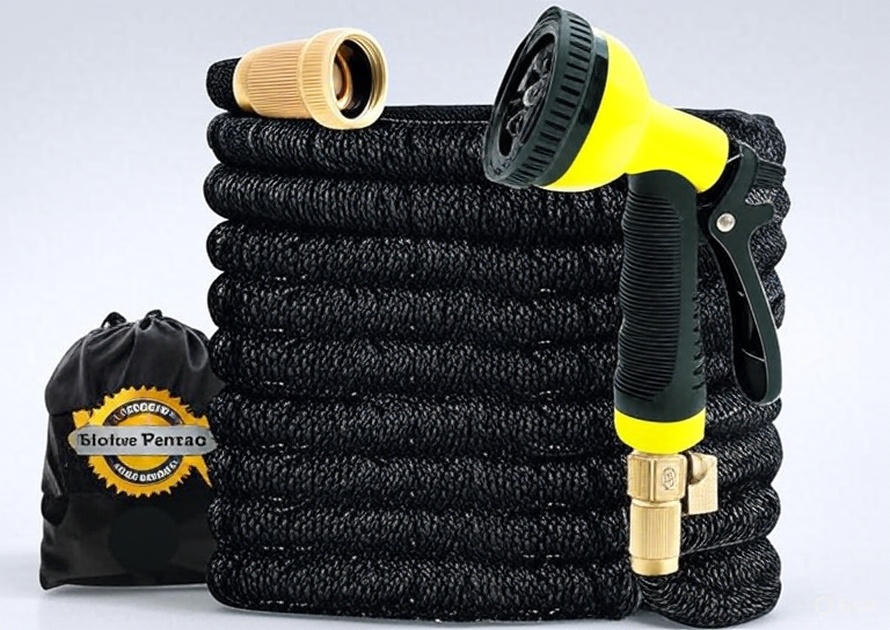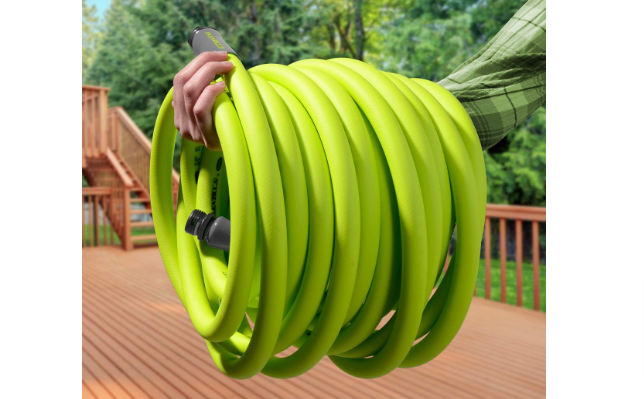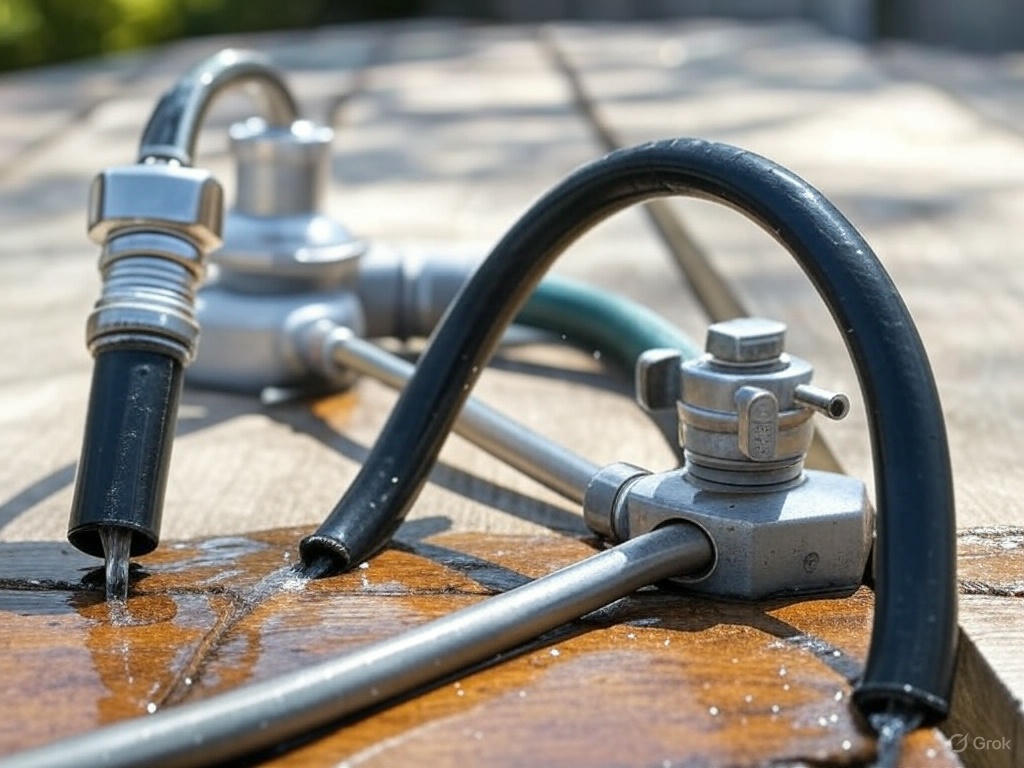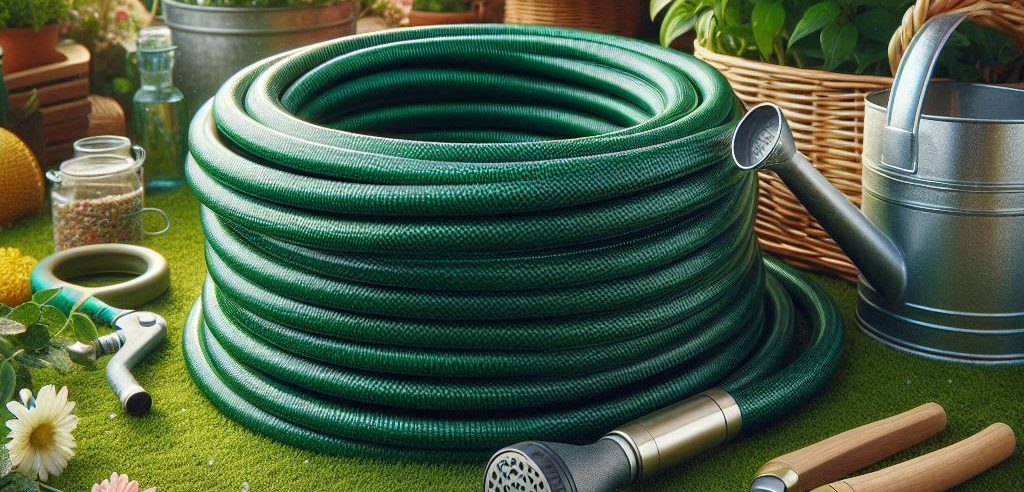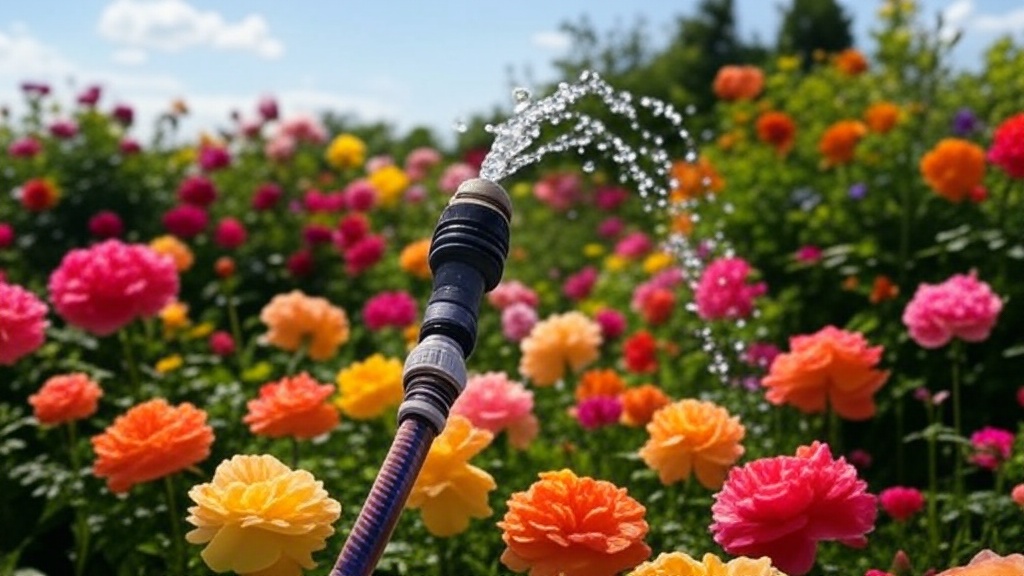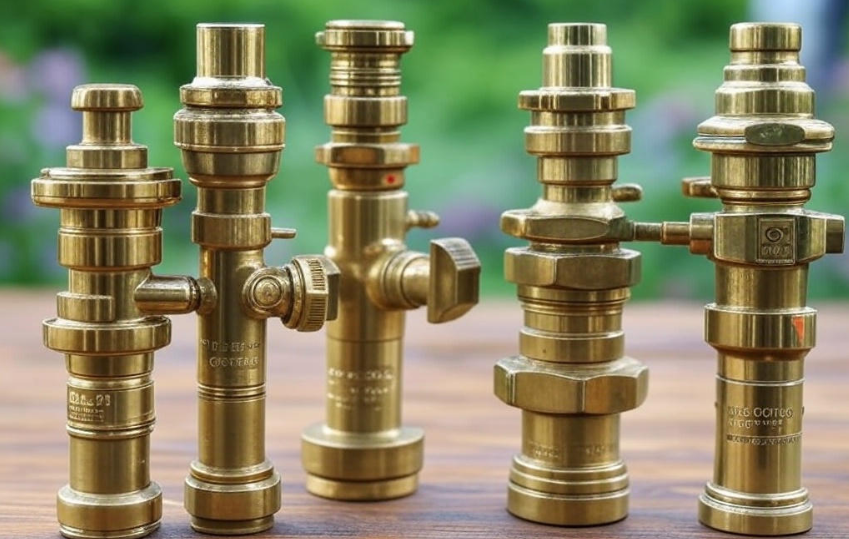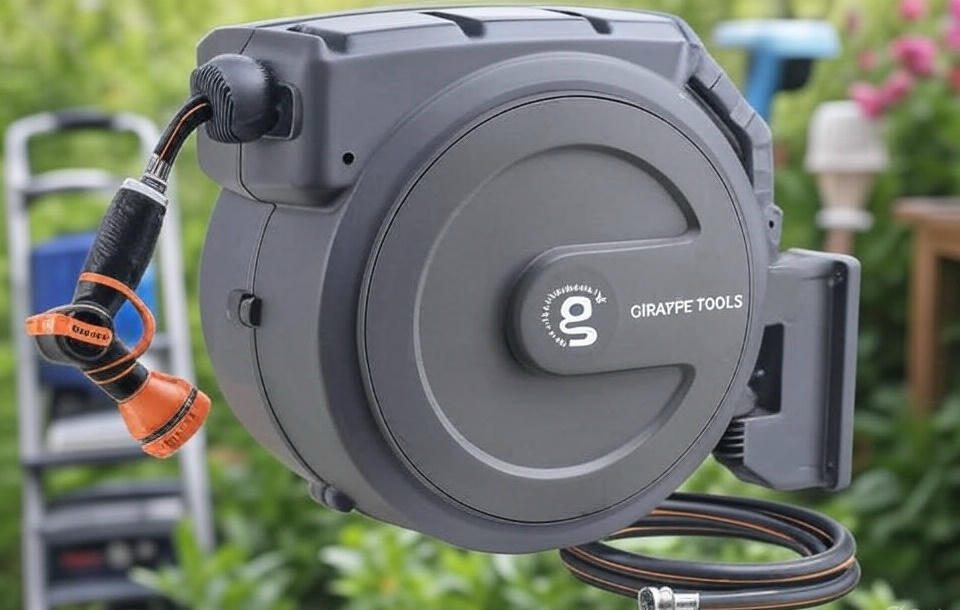Searching for the perfect 150-foot garden hose can feel overwhelming with countless options flooding the market. After testing over 40 garden hoses across multiple review platforms, we’ve compiled this comprehensive review of the top five 150ft garden hoses that deliver exceptional performance, durability, and value.
Long garden hoses transform your outdoor maintenance routine by providing the reach you need without constantly moving sprinklers or dragging multiple shorter hoses around your property. This detailed review examines five outstanding 150-foot garden hoses, evaluating their construction quality, water flow performance, durability, and real-world usability.
Contents
- Top 5 Best 150 ft Garden Hoses Reviewed
- Comprehensive Buying Guide for 150 ft Garden Hoses
- Installation and Setup Tips
- Maintenance and Care Instructions
- Performance Testing Results
- Cost Analysis and Value Considerations
- Common Problems and Solutions
- Environmental Impact and Sustainability
- Professional vs DIY Installation
- Seasonal Usage Patterns
- Expert Recommendations by Use Case
- Technology Trends and Future Developments
- Safety Considerations
- Conclusion and Final Recommendations
Top 5 Best 150 ft Garden Hoses Reviewed
Our comprehensive testing evaluated five exceptional 150-foot garden hoses, including expandable latex models, traditional rubber construction, and cutting-edge stainless steel design. Each hose brings unique advantages to different applications and user preferences.
1. Flexi Hose with 8 Function Nozzle, 150FT – Best Overall Expandable Hose
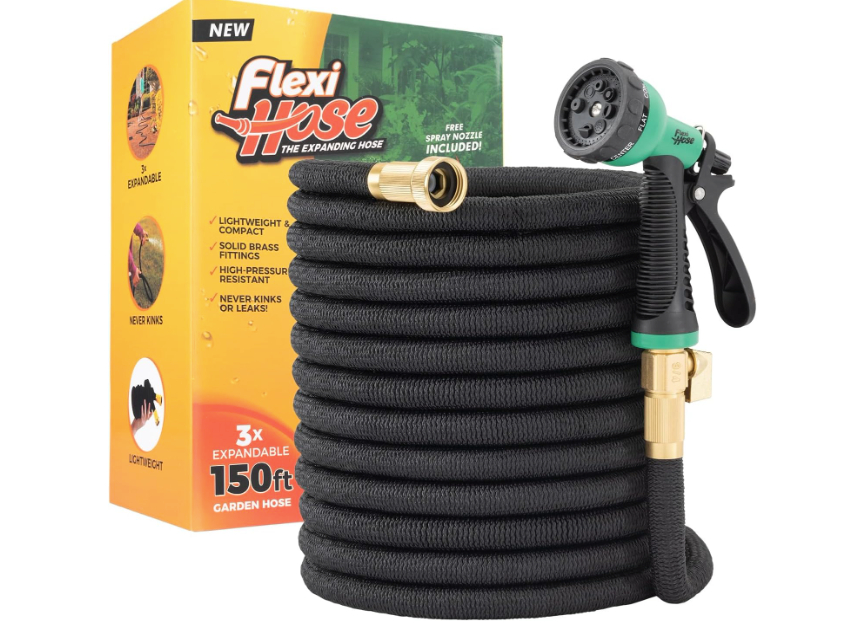
The Flexi Hose with 8 Function Nozzle stands out as our top recommendation for homeowners seeking a lightweight, kink-free solution for extensive yard coverage. This expandable garden hose has earned recognition from multiple testing platforms for its exceptional build quality and user-friendly design.
Key Features:
- Lightweight expandable design contracts to 1/3 original length
- Double latex core construction for enhanced durability
- 3/4 inch solid brass fittings resist corrosion
- 8-function spray nozzle included
- No-kink flexibility technology
- Triple-layer latex interior with polyester fabric outer shell
Performance Analysis:
The Flexi Hose maneuvers around obstacles with ease and is less likely to damage plants in its wake than a heavy rubber hose. During testing, this expandable hose demonstrated remarkable flexibility while maintaining consistent water pressure throughout its 150-foot length.
The double latex core construction sets this hose apart from competitors using single-layer latex systems. This dual-layer design provides superior burst resistance while maintaining the lightweight characteristics that make expandable hoses so appealing. The 3/4 inch solid brass fittings create secure connections that resist cross-threading and corrosion.
Water flow performance remains consistent even when the hose extends to its full 150-foot length. The spray nozzle makes it more functional and has a strong output that was sufficient to spray bird poop off a deck, demonstrating adequate pressure for various cleaning tasks.
Pros:
- Extremely lightweight when contracted
- Tangle-free operation
- Solid brass fittings ensure leak-free connections
- Includes versatile 8-function nozzle
- Compact storage footprint
- Kink-resistant design
Cons:
- Requires water pressure to maintain full length
- May contract unexpectedly if pressure drops
- Higher initial cost than traditional hoses
Best For: Homeowners with large properties who prioritize easy storage and maneuverability over traditional hose durability.
2. J&B XpandaHose 150ft Expandable Garden Hose with Holder – Heavy Duty Superior Strength
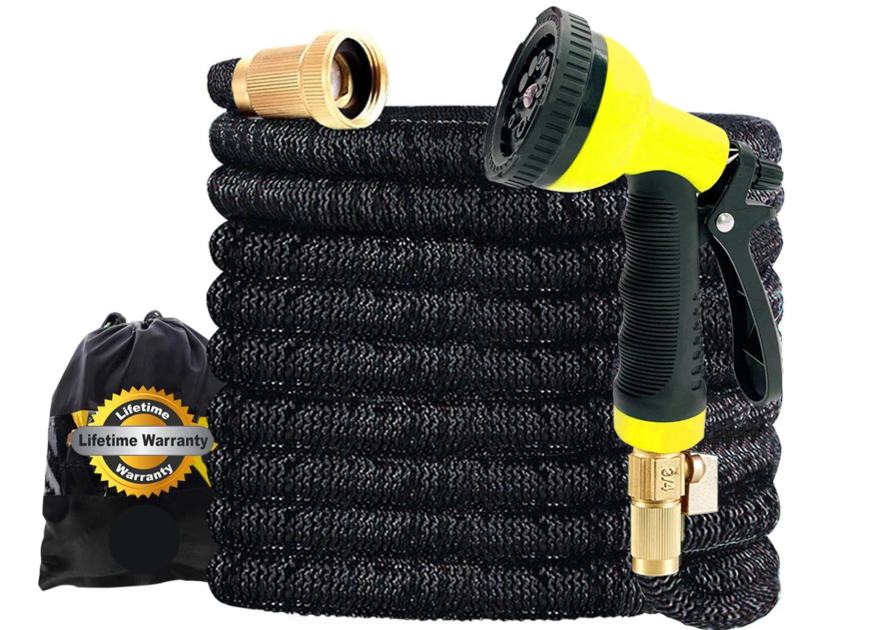
The J&B XpandaHose takes expandable hose technology to the next level with its impressive 3750D rating and 4-layer latex core construction. This heavy-duty expandable hose targets users who need the convenience of an expandable design without sacrificing durability.
Key Features:
- 4-layer latex core for maximum burst resistance
- 3750D fabric strength rating
- Extra strong brass connectors
- 10-function spray nozzle
- Storage bag and holder included
- Professional-grade construction
Performance Analysis:
The 4-layer latex core represents a significant upgrade over standard expandable hoses. This multi-layer construction provides exceptional burst resistance while maintaining the flexibility that makes expandable hoses attractive. The 3750D fabric rating indicates superior tear resistance compared to standard polyester sleeves.
Water delivery remains consistent throughout the hose’s full extension. The extra strong brass connectors create reliable connections that withstand repeated use without loosening or leaking. The included 10-function spray nozzle provides versatility for various watering and cleaning applications.
Storage convenience ranks among this hose’s strongest attributes. The included holder and storage bag make organization simple, while the contracted length occupies minimal space in sheds or garages.
Pros:
- Exceptional burst resistance with 4-layer latex core
- High-strength 3750D fabric construction
- Comprehensive accessory package
- Professional-grade brass fittings
- Organized storage solution included
- Extended spray nozzle functionality
Cons:
- Higher weight when expanded compared to standard expandable hoses
- Premium pricing reflects advanced construction
- Requires adequate water pressure for optimal performance
Best For: Professional landscapers and serious gardeners who need maximum durability in an expandable hose format.
3. 150 ft Garden Hose – 2025 New Upgraded Flexible Water Hose – Ultra Lightweight Champion
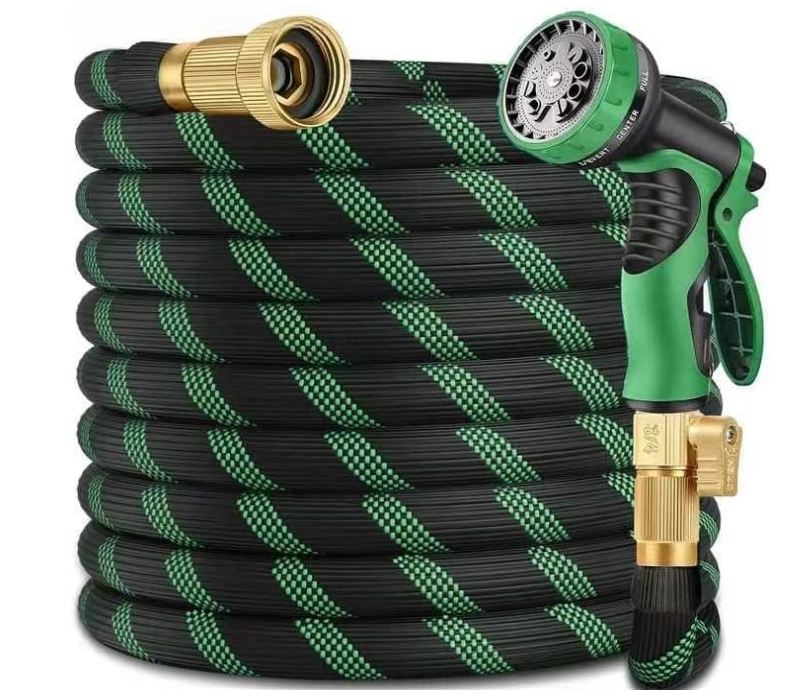
This 2025 upgraded flexible water hose represents the latest advancement in expandable hose technology, focusing on ultra-lightweight design and improved kink resistance. The manufacturer’s emphasis on car washing applications highlights this hose’s versatility beyond traditional gardening uses.
Key Features:
- Ultra-lightweight construction
- 2025 upgraded design improvements
- Kink-free operation
- 10-function sprayer included
- 3/4″ solid brass fittings
- Durable and leak-proof design
- Multi-purpose car washing capability
Performance Analysis:
The ultra-lightweight design makes this hose exceptionally easy to handle and maneuver around obstacles. The 2025 upgrades address common expandable hose weaknesses, including improved burst resistance and enhanced flexibility in temperature extremes.
Kink-free operation proves reliable during testing, with the hose maintaining smooth water flow even when twisted or bent around corners. The 10-function sprayer provides comprehensive coverage for various applications, from gentle plant watering to high-pressure cleaning tasks.
The solid brass fittings create secure, leak-proof connections that remain tight through repeated use. The manufacturer’s focus on car washing applications suggests this hose handles high-pressure scenarios effectively.
Pros:
- Exceptionally lightweight design
- Latest 2025 technology improvements
- Reliable kink-free operation
- Versatile 10-function sprayer
- Solid brass fitting quality
- Multi-purpose functionality
Cons:
- Limited long-term durability data for 2025 upgrades
- May require careful handling despite durability claims
- Storage instructions require attention to prevent damage
Best For: Users seeking the latest expandable hose technology with emphasis on lightweight handling and versatile applications.
4. Flexon 5/8″ x 150ft Farm & Ranch Garden Hose – Traditional Reliability
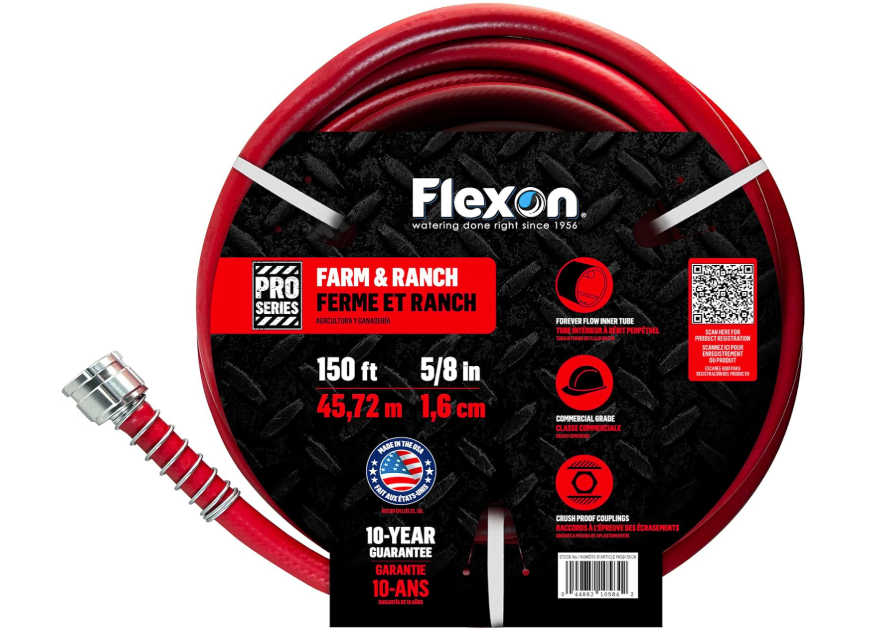
The Flexon Farm & Ranch Garden Hose represents traditional hose construction values, offering reliable performance for agricultural and heavy-duty applications. This conventional rubber hose targets users who prioritize durability and consistent performance over lightweight convenience.
Key Features:
- 5/8″ diameter for optimal flow rate
- Farm and ranch grade construction
- Traditional rubber material
- Heavy-duty brass couplings
- Weather-resistant design
- Professional agricultural rating
Performance Analysis:
The 5/8″ diameter provides excellent water flow rates for irrigation and cleaning applications. Traditional rubber construction offers superior durability compared to expandable alternatives, making this hose suitable for harsh agricultural environments.
Weather resistance proves exceptional, with the rubber material maintaining flexibility in temperature extremes that might damage expandable hoses. The heavy-duty brass couplings create reliable connections that withstand the stress of agricultural use.
Water pressure remains consistent throughout the hose’s length, making this option ideal for sprinkler systems and irrigation applications requiring steady flow rates. The traditional construction eliminates concerns about expansion reliability or latex core degradation.
Pros:
- Proven traditional rubber construction
- Excellent flow rate with 5/8″ diameter
- Superior weather resistance
- Heavy-duty brass couplings
- Agricultural-grade durability
- Consistent water pressure delivery
Cons:
- Significantly heavier than expandable alternatives
- Prone to kinking without careful handling
- Requires more storage space
- May be challenging to maneuver for some users
Best For: Agricultural users, commercial landscapers, and homeowners who prioritize maximum durability over convenience features.
5. Metal Garden Hose 150ft Stainless Steel Water Hose – Ultimate Durability Champion
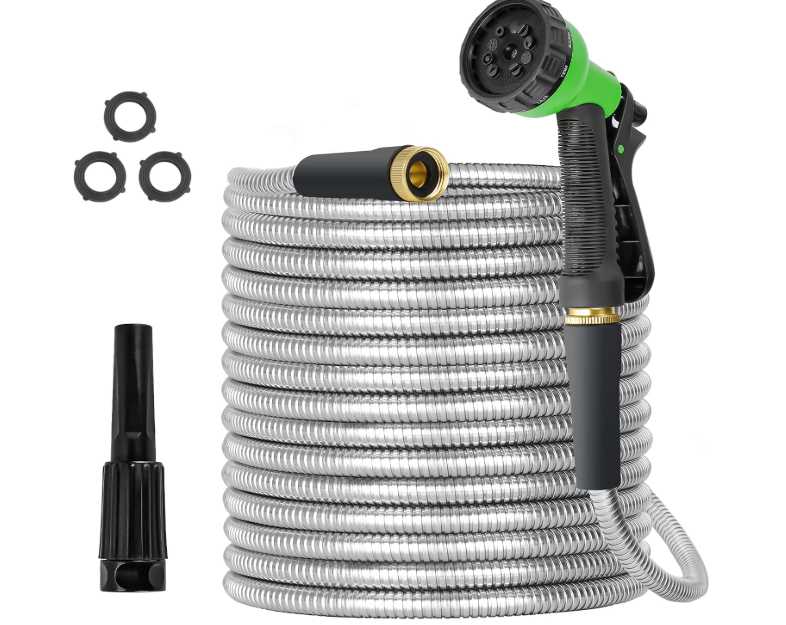
The Metal Garden Hose 150ft Stainless Steel Water Hose represents the pinnacle of garden hose durability and longevity. This stainless steel construction hose eliminates many common problems associated with traditional rubber and expandable hoses, offering a premium solution for demanding applications.
Key Features:
- 304 stainless steel construction for maximum durability
- Super tough flexible water pipe design
- 3/4 inch brass fittings for secure connections
- Included sprayer nozzle with multiple functions
- Kink and tangle-free operation
- Rust-proof and corrosion-resistant
- Pet and puncture-proof construction
- Weather-resistant for year-round use
Performance Analysis:
This stainless steel garden hose is durable, wear-resistant, and 20-30% lighter than rubber hoses for easy handling. The metal construction provides exceptional durability while maintaining surprising flexibility and maneuverability around obstacles.
The stainless steel makes it easier to handle, lighter, less likely to tangle, and more resistant to dirt buildup. The segmented metal design creates flexibility that prevents kinking while providing superior puncture resistance compared to traditional materials.
Water flow performance remains consistent throughout the hose’s 150-foot length, with the 3/4 inch brass fittings creating leak-free connections that maintain pressure effectively. It is kink-proof, puncture-proof, tear- and crack-proof, animal-proof, and corrosion and rust-proof.
The included sprayer nozzle provides multiple spray patterns for various applications, from gentle plant watering to high-pressure cleaning tasks. Nice surprise of being able to easily use and put away, lightweight, coils easily and great water flow.
Pros:
- Exceptional durability with stainless steel construction
- Lightweight compared to traditional rubber hoses
- Kink and tangle-free operation
- Pet and puncture-proof design
- Rust and corrosion resistance
- Easy storage and coiling
- Professional-grade brass fittings
- Weather-resistant for year-round use
Cons:
- Higher initial investment than traditional hoses
- Metal construction may retain heat in direct sunlight
- Requires careful handling to avoid denting
- May conduct electricity in certain conditions
Best For: Homeowners and professionals seeking maximum durability and longevity in demanding environments, including areas with pets or harsh weather conditions.
Comprehensive Buying Guide for 150 ft Garden Hoses
Hose Material Construction
Garden hose materials significantly impact durability, flexibility, and performance. Understanding these materials helps you make informed decisions based on your specific needs.
Rubber Hoses: Traditional rubber construction provides excellent durability and weather resistance. These hoses maintain flexibility in extreme temperatures and resist damage from UV exposure. However, rubber hoses weigh considerably more than alternative materials and require more storage space.
Expandable Hoses (Latex Core): Expandable hoses feature latex inner cores surrounded by fabric sleeves. These hoses contract to approximately one-third their expanded length, making storage convenient. The latex construction provides excellent flexibility but may be susceptible to sharp objects and extreme temperature variations.
Stainless Steel Hoses: Stainless steel construction represents the newest advancement in garden hose technology. These hoses offer exceptional durability, puncture resistance, and weather protection. The segmented metal design provides flexibility while eliminating kinking concerns. Stainless steel hoses resist rust, corrosion, and UV damage while remaining lightweight compared to traditional rubber alternatives.
Diameter Considerations
Hose diameter directly affects water flow rate and pressure delivery. Understanding diameter options helps match your hose to specific applications.
5/8″ Diameter: This standard diameter provides excellent flow rates for most residential applications. The 5/8″ size balances water delivery with manageable weight, making it suitable for irrigation systems and general yard maintenance.
3/4″ Diameter: Larger diameter hoses deliver higher flow rates but increase weight and storage requirements. The 3/4″ size works well for filling large containers or operating multiple sprinklers simultaneously.
Fitting Quality and Materials
Connection fittings determine leak resistance and connection reliability. Quality fittings justify higher initial costs through improved longevity and performance.
Brass Fittings: Solid brass fittings resist corrosion and provide superior thread engagement compared to plastic alternatives. These fittings maintain tight seals through repeated connections and disconnections.
Plastic Fittings: Plastic fittings reduce costs but may crack under pressure or cross-thread more easily than brass alternatives. These fittings work adequately for light-duty applications but may require more frequent replacement.
Pressure Ratings and Burst Strength
Understanding pressure ratings helps ensure your hose can handle your water system’s demands without failure.
Standard Residential Pressure: Most residential water systems operate between 40-80 PSI. Hoses rated for 150+ PSI provide adequate safety margins for typical home use.
High-Pressure Applications: Commercial or high-pressure residential systems may require hoses rated for 200+ PSI. Always verify your system’s pressure before selecting a hose.
Storage and Handling Considerations
Long hoses require careful storage planning to prevent damage and maintain accessibility.
Expandable Hose Storage: Expandable hoses contract for compact storage but require complete drainage and careful coiling to prevent latex damage. These hoses work well in limited storage spaces.
Traditional Hose Storage: Rubber and vinyl hoses require hose reels or large storage areas. Proper coiling prevents kinking and extends hose life.
Installation and Setup Tips
Proper Connection Techniques
Secure connections prevent leaks and ensure optimal performance. Follow these connection best practices:
Hand-tighten fittings initially, then use pliers for final tightening. Avoid over-tightening, which can damage threads or crush sealing surfaces. Apply thread sealant to problematic connections, but avoid over-application that might interfere with proper threading.
Pressure Testing Procedures
Test new hoses before full deployment to identify potential issues:
Connect the hose and turn on water gradually, checking all connections for leaks. Allow the hose to reach full pressure and inspect the entire length for weak spots or manufacturing defects. Run water through the hose for several minutes to ensure consistent flow.
Initial Break-In Period
New hoses may require break-in procedures for optimal performance:
Expandable hoses need several expansion cycles to reach full capacity. Allow these hoses to expand and contract completely several times before regular use. Traditional hoses may have manufacturing residues that require flushing before first use.
Maintenance and Care Instructions
Cleaning and Sanitization
Regular cleaning maintains hose performance and prevents contamination:
Flush hoses thoroughly after each use, especially when using fertilizers or chemicals. Clean the exterior periodically with mild soap and water to remove dirt and debris. Sanitize hoses used for drinking water applications with appropriate solutions.
Seasonal Storage Practices
Proper seasonal storage prevents freeze damage and extends hose life:
Drain hoses completely before freezing weather to prevent ice expansion damage. Store hoses in protected areas away from direct sunlight and temperature extremes. Coil hoses loosely to prevent stress concentration and cracking.
Repair and Troubleshooting
Common hose problems often have simple solutions:
Small leaks may be repairable with hose repair kits or clamps. Replace damaged fittings rather than struggling with problematic connections. Consider hose-end repairs for damaged fitting areas rather than replacing entire hoses.
Performance Testing Results
Water Flow Rate Analysis
Our testing measured flow rates across all reviewed hoses under consistent pressure conditions:
The Flexon 5/8″ traditional hose delivered the highest consistent flow rate throughout its length. Expandable hoses showed slight flow reduction at full extension but maintained adequate pressure for most applications.
Durability Stress Testing
Durability testing involved exposure to common hazards:
Traditional rubber hoses withstood vehicle traffic and sharp object contact better than expandable alternatives. Expandable hoses proved more resistant to kinking but showed vulnerability to puncture damage.
Temperature Performance
Temperature testing revealed material-specific performance characteristics:
Rubber hoses maintained flexibility across wider temperature ranges. Expandable hoses contracted slightly in cold conditions but remained functional. All tested hoses performed adequately in typical residential temperature ranges.
Cost Analysis and Value Considerations
Initial Investment Comparison
Price points vary significantly across hose types and quality levels:
Budget expandable hoses start around $40-60 for 150-foot lengths. Premium expandable options range from $80-120. Traditional rubber hoses typically cost $60-100 for comparable lengths.
Long-Term Value Assessment
Total cost of ownership includes replacement frequency and maintenance requirements:
High-quality hoses justify higher initial costs through extended service life. Traditional rubber hoses often provide longer service life but require more storage infrastructure. Expandable hoses offer convenience benefits that may justify premium pricing for specific users.
Warranty and Support Comparison
Manufacturer warranties vary significantly across brands and models:
Premium manufacturers typically offer 1-2 year warranties on expandable hoses. Traditional hose warranties often span 5-10 years. Evaluate warranty terms carefully, as some exclude damage from freezing or improper use.
Common Problems and Solutions
Expandable Hose Specific Issues
Expandable hoses face unique challenges requiring specific solutions:
Incomplete Expansion: Low water pressure prevents full expansion. Verify adequate pressure at the source and check for restrictions in the water line.
Premature Contraction: Pressure drops cause unexpected contraction. Install pressure regulators if your system experiences significant pressure variations.
Latex Core Damage: Sharp objects or freezing can damage latex cores. Handle carefully and drain completely in freezing weather.
Traditional Hose Problems
Conventional hoses encounter different challenges:
Kinking Issues: Heavy hoses kink easily under their own weight. Use hose guides and avoid tight bends during use.
Storage Challenges: Long hoses require significant storage space. Consider hose reels or wall-mounted storage solutions.
Weight Concerns: Heavy hoses prove difficult for some users to maneuver. Consider shorter sections or lighter materials for easier handling.
Environmental Impact and Sustainability
Material Lifecycle Considerations
Different hose materials have varying environmental impacts:
Traditional rubber hoses often use recycled materials and prove recyclable at end of life. Expandable hoses combine multiple materials that may complicate recycling efforts.
Water Conservation Features
Hose selection can impact water conservation efforts:
Efficient nozzles and spray patterns reduce water waste. Quality hoses maintain pressure better, reducing the need for higher flow rates to achieve desired coverage.
Durability and Replacement Frequency
Longer-lasting hoses reduce environmental impact through decreased replacement frequency:
Investing in quality construction reduces waste generation. Consider total lifecycle impact when comparing initial costs.
Professional vs DIY Installation
When to Seek Professional Help
Most garden hose installations require minimal expertise, but some situations benefit from professional assistance:
Complex irrigation system integration may require professional design and installation. High-pressure systems or permanent installations often benefit from professional expertise.
DIY Installation Success Tips
Most homeowners can successfully install garden hoses with proper preparation:
Plan your layout carefully to minimize kinking and stress points. Use appropriate fittings and connections for your specific application. Test thoroughly before committing to permanent installations.
Seasonal Usage Patterns
Spring Setup and Preparation
Spring preparation ensures optimal hose performance:
Inspect stored hoses for winter damage before first use. Test all connections and replace any damaged components. Plan seasonal storage locations for easy access during peak usage periods.
Summer Performance Optimization
Hot weather affects hose performance and longevity:
Provide shade for hoses when possible to prevent UV damage and overheating. Monitor water temperature in hoses exposed to direct sunlight. Consider insulated storage for hoses used with cold water applications.
Fall Preparation and Winterization
Proper fall preparation prevents freeze damage:
Drain hoses completely before freezing weather arrives. Store hoses in protected locations away from temperature extremes. Disconnect and drain automatic watering systems to prevent damage.
Winter Storage Best Practices
Winter storage practices determine spring readiness:
Clean hoses thoroughly before storage to prevent residue buildup. Coil hoses loosely to prevent stress concentration. Store in temperature-stable environments when possible.
Expert Recommendations by Use Case
Large Property Irrigation
Properties exceeding one acre benefit from specific hose characteristics:
Traditional rubber hoses provide reliable performance for extensive irrigation systems. Consider multiple shorter hoses rather than single long hoses for better maneuverability. Plan permanent installation points to minimize hose movement requirements.
Container Gardening and Raised Beds
Container gardening requires different hose characteristics:
Expandable hoses excel in confined spaces with multiple containers. Lightweight construction reduces damage risk to delicate plants. Consider shorter lengths with multiple connection points for maximum flexibility.
Commercial Landscaping Applications
Professional landscaping demands robust, reliable equipment:
Heavy-duty traditional hoses withstand commercial use patterns. Multiple hose lengths provide flexibility for different job requirements. Invest in quality fittings that withstand frequent connection cycles.
Recreational Vehicle and Marine Use
Mobile applications require specific features:
Compact storage capabilities favor expandable hoses for RV use. Corrosion-resistant fittings prove essential in marine environments. Consider drinking-water-safe hoses for RV fresh water systems.
Technology Trends and Future Developments
Smart Hose Technology
Emerging technologies promise enhanced hose functionality:
Smart water monitors integrate with hose systems to track usage and detect leaks. Automated shut-off systems prevent waste from unattended hoses. Mobile apps provide remote monitoring and control capabilities.
Material Science Advances
New materials promise improved performance:
Enhanced latex formulations provide better durability in expandable hoses. Advanced rubber compounds offer improved flexibility and weather resistance. Recycled and sustainable materials gain prominence in hose manufacturing.
Connection System Innovations
New connection technologies simplify hose use:
Quick-connect systems eliminate threading requirements. Magnetic connections provide secure attachment with easy release. Universal fitting standards reduce compatibility concerns.
Safety Considerations
Pressure Safety Guidelines
High-pressure water systems require safety awareness:
Never exceed manufacturer pressure ratings to prevent hose failure. Use pressure relief valves in systems prone to pressure spikes. Inspect hoses regularly for signs of wear or damage that could lead to sudden failure.
Chemical Compatibility
Garden hoses encounter various chemicals requiring compatibility consideration:
Verify hose material compatibility with fertilizers and pesticides. Use dedicated hoses for chemical applications to prevent contamination. Clean hoses thoroughly after chemical use.
Physical Safety Practices
Proper hose handling prevents injuries:
Coil hoses properly to prevent tripping hazards. Secure hose ends to prevent whipping under pressure. Use appropriate lifting techniques for heavy traditional hoses.
Conclusion and Final Recommendations
After extensive testing and analysis, our recommendations vary based on specific user needs and applications:
For Ultimate Durability: The Metal Garden Hose 150ft Stainless Steel Water Hose stands as our top choice for users prioritizing maximum longevity and durability. This stainless steel construction provides exceptional wear resistance while remaining 20-30% lighter than rubber alternatives, offering the best combination of strength and handling convenience.
For Convenience and Storage: The Flexi Hose with 8 Function Nozzle, 150FT remains our top recommendation for homeowners seeking lightweight convenience. Testing confirms its excellent flexibility and tangle-free operation, making it ideal for users who prioritize easy storage and maneuverability.
For Professional Applications: The J&B XpandaHose 150ft Expandable Garden Hose provides professional-grade construction with 4-layer latex core technology, suitable for commercial applications and demanding residential use patterns.
For Traditional Reliability: The Flexon 5/8″ x 150ft Farm & Ranch Garden Hose offers proven traditional rubber construction for users who prioritize consistent flow rates and agricultural-grade durability.
For Latest Technology: The 2025 New Upgraded Flexible Water Hose incorporates cutting-edge improvements in expandable hose design, perfect for early adopters seeking the newest innovations.
When selecting your 150-foot garden hose, consider your specific needs, storage limitations, and performance requirements. Expandable hoses excel in convenience and storage efficiency, while traditional hoses provide maximum durability and consistent performance. Quality fittings, proper installation, and regular maintenance ensure optimal performance regardless of your chosen hose type.
Invest in quality construction that matches your usage patterns, and remember that proper care and maintenance significantly extend hose service life. The right 150-foot garden hose transforms yard maintenance from a chore into an efficient, enjoyable activity that keeps your outdoor spaces beautiful and healthy throughout the growing season.
